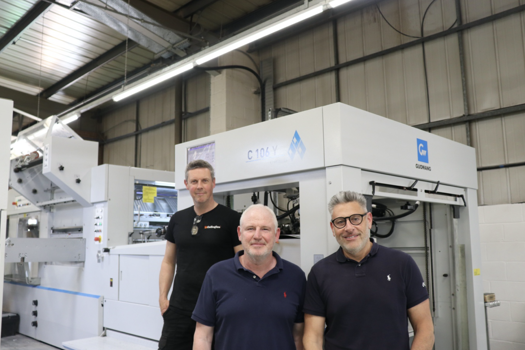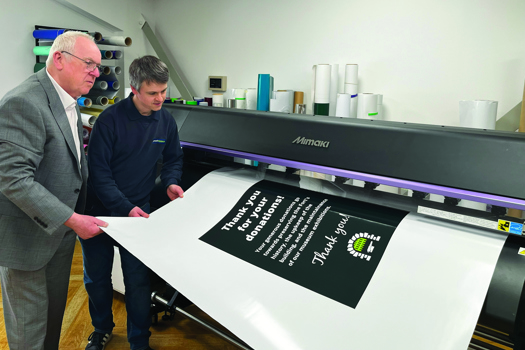Developed for efficient production of high-quality signage, the new JV200-160 is a roll-to-roll device designed for the sign graphics market that uses eco-solvent inks and prints at a practical production speed of 17sqm/hr.
Arjen Evertse, director sales at Mimaki Europe, said: “Our CJV200 Series of integrated printer/cutters, introduced last October, has been extremely well received by the market.
“The JV200-160 joins this product series to deliver the same exemplary image quality and top-level productivity for the entry class – now in a print-only model that’s easy to operate and maintain.”
He told Printweek: “The print-only version is basically for two reasons; there are people who prefer to have machines that only print, because they don't need a cutting option. And there are people who prefer to have a print only version because they prefer to separate the printing and cutting – we are targeting both customer types with this machine.
“Technology wise it’s identical to the CJV200 and has a unique balance in terms of quality and speed. There are a lot of printers that can print nice pictures and that can print fast, but there are not so many that can do fast and nice at the same time.
“And I think what is very unique in the 200 engine is the level up to which we can increase the speed without having the expected quality drop.”
When paired with a Mimaki cutting plotter, the JV200-160 can also benefit from the manufacturer’s ID Cut function, which is said to automate print-and-cut processes with minimal operator intervention, reducing the risk of human error.
Mimaki’s recently launched SS22 eco-solvent ink is available with the JV200-160. This ink reduces odour by approximately 40% compared to in-house ink, based on Mimaki’s evaluation, and does not contain GBL, the use of which has been increasingly regulated around the world. The ink nevertheless still provides high outdoor weather resistance.
The JV200-160 also supports Mimaki’s SS21 and BS4 inksets.
Other features of the printer include the Ink Saving function, and the automatic media adjustment function DAS (Dot Adjustment System), which is said to enable easy and accurate pre-print adjustment.
The machine also incorporates Mimaki’s Printer Information Cloud Technology (PICT), which is said to optimise ink efficiency and maintenance while providing the option for remote monitoring, grouped management, and improved data precision.
The JV200-160, which replaces the JV100 in Mimaki’s portfolio, is also being demonstrated live for the first time in EMEA on Mimaki’s stand (1.2-B20) at Fespa, which runs from 6-9 May at Messe Berlin. The first volume shipments of the printer are expected around May/June time.
Another stand highlight is the launch of a direct-to-film (DTF) UV printer that can effectively produce stickers made of just ink and varnish – which can be applied to objects of all shapes and sizes.
The 650mm-wide UJV300DTF-75 prints onto film at up to 1,200dpi. Fitted with six colour channels, the machine uses a combination of Mimaki’s new generation of UV inks to produce a ‘hard’ layer of white, printed over in CMYK ‘soft’ inks, with a ‘hard’ layer of clear ink over the top.
The new inks, flexible ink ELS-170 and hard ink ELH-100, are likewise being launched and demonstrated for the first time at Fespa, having been designed specifically to comply with the EU’s REACH regulations.
These inks have been formulated to be completely free of SVHC and CMR (Carcinogenic, Mutagenic, and Reproductive toxicants), therefore reducing the impact on human health and the environment. Additionally, the odour emitted when using ELS and ELH inks is said to be reduced by around 30% compared to conventional UV inks, providing a more comfortable working environment.
Mimaki said the new inks maintain the same high scratch resistance as the conventional LH-100, while the ELS inks provide the same flexibility as the conventional LUS-120. The ELS and ELH inks are scheduled for gradual release after June 2025.
The setup of the UJV300DTF-75 allows users to produce print on film that can then be peeled and directly applied to objects of irregular shapes or sizes that would otherwise be impossible to print on in a rotary ‘kebab’ style printer or flatbed. No curing is required to adhere the print to the object.
Commercial availability for the UJV300DTF-75 is currently planned for September.
Also on show at Mimaki’s booth are the EMEA debut of the recently launched direct-to-textile Tx330-1800; the JFX200-1213 EX flatbed for compact printing and signage; the print and cut CJV200-160; the TS330-3200DS 3.2m hybrid printer that supports both direct printing on fabrics and sublimation transfer paper; and the TRAPIS pigment transfer printer.
The Tx330 Series printers are equipped with dual inkset capability to easily switch between textile pigment inks and dye-sub inks.
Unlike conventional dye inks, these are said to simplify the process with a straightforward printing and heat fixation procedure. This eliminates the need for extensive facilities for water supply, drainage, and wastewater treatment, as well as the dyeing expertise needed to operate.
The Tx330-1800 can print on both fabric and paper, making it suitable for producing textile signage and interior fabrics.
There is also a version with a space-saving belt conveyor available, the Tx330-1800B, which isn't at Fespa.
The Tx330-1800 Series, which will be available in June, utilises Mimaki’s ‘330 Engine’ so provides the same sharp details, smooth colouring, and accurate colour printing as other machines in the 330 Series due to smooth gradation expression and high-density printing capabilities.
Fespa also sees the commencement of the manufacturer’s 50th anniversary celebrations, which it is marking with the new slogan ‘Print Different’.
Finally, Mimaki has revealed that its 330 series of flagship printers (JV330 and CJV330) and the Eco-Solvent inks SS21 and BS4 used in these printers have recently been approved for the 3M MCS Warranty Program.










